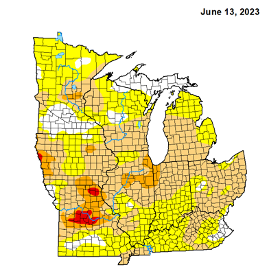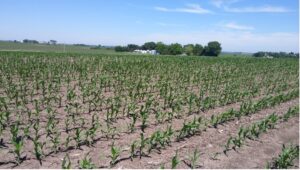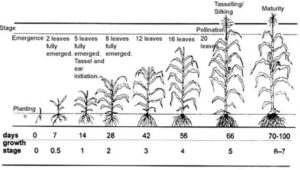Drought Stress on Corn Development
By Louis Kuisle | June 22, 2023
For the last few weeks, the lack of rainfall throughout the Midwest has been the number one topic in agriculture. Variable rains are leaving areas with enough moisture to keep pushing forward, while others are left with crops struggling. As we see the grain markets rallying on the prospect of reduced yields, one can’t help but wonder if there is anything else that can be done to protect yield at this early stage of development. Before throwing the kitchen sink and checkbook at preservation, it should be understood just how much damage is potentially occurring. (fig 1 curtesy of U.S. Drought Monitor)


Emergence
Issues we are currently seeing include the obvious rolling of leaves and plants that are falling behind in height and color. In many areas, delayed and uneven emergence are the biggest concern currently. As we progress through the corn growth stages, drought stress affects corn in different ways and to varying degrees of severity.
Seed that couldn’t imbibe enough water to germinate or germinate at the same rate as neighboring plants has been widespread this year. In some cases, the seed has not begun the process at all and may still be viable if a source of moisture becomes available. There are varying schools of thought on how much damage uneven emergence will cause. The University of Wisconsin performed a well-founded trial many years ago that outlined resulting yield percentages with percent delayed and time/stage of delayed plants. See: Uneven Emergence in Corn (NCR344) (wisc.edu) There are many variables to consider, but “good” yields can still be achieved with a substantial volume of delayed plants. It is well documented that singular plants delayed from their neighbors will nearly become weeds, but for more substantial patches, howdelayed those plants are compared to the calendar plays the more significant role.

Setting the Stage
Ear girth starts being determined by the plant at V5 (10-14” tall) and hits its most crucial stage around V7 (20-24” tall). During this time the number of kernels around the ear will be determined. Heavy drought stress during this time frame can reduce the number of kernels around the ear is. A common example of stress during this phase would be if a hybrid that is known for being 18-20 kernels around comes in at 16. Misapplication of herbicides, over saturated soils, and frost events are all stress factors that can cause reduced development during this period as well. Beyond V7 Kernel rows (length) begin to be determined and continue through V15-V16. All the same issues that reduce the number of kernel rows around in the earlier stages will limit potential kernel row length.

Pollination
As we push closer to the reproductive stages, drought stress can cause problems with pollination. High temps and low humidity are not good for corn pollination. Pollen becomes no longer viable with are temps exceeding 95 degrees F, especially with low humidity. Drought stress in the days leading up to pollination starting at about V15 can accelerate tassel development and pollen shed, while simultaneously delaying silk. Silks emerge from the tip of the ear last. The delay in silk emergence can cause those silks to miss the pollen window and create “tip-back”. Pollination is arguably the most important stage in overall corn development. Even a well-developed ear can under-produce or fail if stress factors become too high.

Kernel development
After a kernel is successfully pollinated, they will develop into the blister stage in about 10 days. This stage will last for a little over a week before moving into the milk stage. Milk stage will last about a week before transitioning into the dough stage. The stages of pollination, blister and then milk tend to be more important than the later stages of kernel development. Kernels can still be lost during this 20–25-day timeframe of early pollination due to stress. Once dough begins and the ear progresses towards dent, the kernel size will be the main changes that occur to the ear itself. The plant maintaining nutrient flow within itself will keep kernels filling up until physiological maturity.

